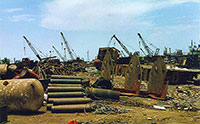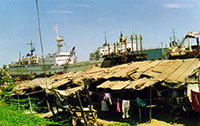Indian Ship Breakers Risk Contamination
Indian Ship Breakers Risk Contamination
by Marcel Herbke (mherbcat), OhmyNews International (South Korea)
 |
 |
 |
 |
| |
 |
|
| |
Alang shipyard, circa 1998 |
|
 |
 |
 |
 |
 |
 |
| |
 |
|
| |
The workers' houses are extremely
close to the shipyards. |
|
 |
 |
 |
|
| |
19 January 2006 – While the anti-whaling protesters in the southern oceans have been grabbing much media attention and pulling the emotional heart strings of closet environmentalists all over the world, a more real threat to the worlds environment has been slowly smoldering away in Asia for years. It's the ship breaking scrap yards of India and Bangladesh. They are toxic wastelands on once pristine coastal areas where the developed world sells their garbage as scrap metal.
One such case is the retired French aircraft carrier "The Clemenceau" that has been at the center of a waste disposal argument recently between France, Egypt, India and Greenpeace. After 36 years as a linchpin in the French Navy, the Clemenceau was withdrawn from service in 1997. She's been gutted of her massive engines, helicopters, missile systems and cannons, but is still awaiting a proper burial.
High levels of asbestos were used in the construction of the old warship as well as numerous other hazardous chemicals. Under the 1989 Basel Convention -- an international treaty which prohibits the export of hazardous waste from rich countries to poor countries, France must first decontaminate the Clemenceau of these dangerous substances before being able to sell it to international scrap yards.
In 2003, an attempt to have the boat shipped to Turkey failed when Turkey refused its entry. This was followed by an attempt to have it decontaminated in Greece before selling it to Bangladesh, but this also failed when Greece too refused entry.
In December last year, France had 115 tons of surface asbestos removed from the Clemenceau and floated the old warship under tugboat guidance, out of Toulon bound for the Alang scrap yard in India. But according to Technopure, the company originally contracted by the French government to decontaminate the ship, between 500 and 1,000 tons of asbestos still remain on board.
Not surprisingly, action groups such as Greenpeace have got involved to persuade France to take back the Clemenceau, and decontaminate her properly. First two Greenpeace activists boarded the ship in international waters and hung a banner saying "Asbestos carrier: Stay out of India". Then on Jan. 13 after consulting Greenpeace, Egyptian port authorities temporarily denied the ship access to the Suez Canal.
After three days circling at sea, Paris finally negotiated a passage for the Clemenceau by claiming that the ship is still registered to the French Navy, is not yet scrap and therefore is not affected by the Basil Convention. A call from French President Jacques Chirac sped things up, Egypt accepted Frances explanation, and the Clemenceau is now approaching India.
However, India may not want the old ship as its Supreme Court Monitoring Commission (SCMC) already gave a preliminary rejection to France this month. It has also warned France to stay away until its final decision, which is due before Feb. 13. Judges Arijit Praseyal and S.H. Kapadia took a tough line saying, "Why should the ship be allowed in the country? There should be some mechanism by which we can turn it back."
Jim Puckett of the Basel Action Network said:
"France has repeatedly tried to evade its responsibility regarding the Clemenceau. Their standards for handling asbestos are amongst the highest in the world. But instead of investing in safe removal and disposal of the asbestos on the Clemenceau, they are trying to dupe the Indian government, and dump their toxic wastes onto the poorest of the poor of the world. This is absolutely reprehensible; certainly not the kind of attitude one would expect of a supposedly civilized nation."
Jacob Hartmann a Greenpeace Toxins Campaigner adds:
"Due to the high levels of asbestos on board, it is clear that the Clemenceau is an illegal export of hazardous waste to India. This floating toxic behemoth is a shameful symbol of how developed countries are so willing and apparently able to dump their rubbish into the back gardens of developing countries."
This is a practice that has been going on for years. The environmental, as well as health and safety costs involved with breaking up old ships properly, were simply too much for western countries to deal with. So, since the late 1970s ship breaking yards in Asia have been shouldering that burden for us. Out of sight, out of mind. The ship breakers reclaim about 95 percent of the boats' 20,000 to 50,000 tons in the form of scrap metal that they use for their economies. Parts that have no salvage value are simply burnt off or dumped into the surrounding water systems. Something that gets up the noses of environmental groups. Due to the value of the scrap metal, shipowners literally sell their garbage to Asian ship breaking yards for up to US$8 million a vessel.
India currently takes about 60 percent of the worlds used ships. In the West, workers need special equipment and procedures to handle some of the toxic chemicals that the ship breaking process produces. However, in India the situation is a little different. Workers have no protective gear, wear sandals and constantly breathe toxic fumes and deadly asbestos dust. Huge hulls are cut using basic torch cutters and torn apart using crowbars and bare hands. Pipes often still containing gas explode and chemical fires rage as paints, batteries, rubber, old oil and plastics litter the sites. Death in the scrap yards is a common occurrence with reported figures currently between 300 and 400 deaths a year at Alang -- something that gets up the noses of human rights groups.
Those who survive site accidents unfortunately also have a very high chance of developing cancer or one of many other deadly illnesses related to asbestos dust and toxic chemical inhalation. Asked why they do it when the risk is so high, one worker replied, "it's either one dead, or five dead, which is what it would be if I didn't work."
Working for about eight cents an hour, the workers take pieces of asbestos from the ships to sell. These often end up being stored in their sleeping quarters or eating areas. A practice such as this would bring in emergency teams in biohazard suits in Europe or America. Whole areas would be roped off for decontamination due to toxic materials on site. Here in the Alang scrap yards, about 40,000 people live with these conditions 24-7.
The soil, air and surrounding water systems have been tested and have some of the most dangerously high levels of chemical and mineral toxins in the world. A result of which is the 20km stretches of dead polluted coastlines around ship breaking yards in India and Bangladesh. Fishermen who once worked the area have since left, as has the animals and plant life.
The French government know all this, as do the Indian Supreme Court. So does Egypt, Greenpeace and everyone else involved. The issue is not really what is going on but if anyone wants it to change. How the Clemenceau incident plays out will be a good indicator as to how international governments view the dangers and how much they care.
Photos courtesy of Mark Moxon. You can find more photos on his travel website.
FAIR USE NOTICE. This document contains copyrighted material whose use has not been specifically authorized by the copyright owner. The Basel Action Network is making this article available in our efforts to advance understanding of ecological sustainability and environmental justice issues. We believe that this constitutes a 'fair use' of the copyrighted material as provided for in section 107 of the US Copyright Law. If you wish to use this copyrighted material for purposes of your own that go beyond 'fair use', you must obtain permission from the copyright owner.
More News
|